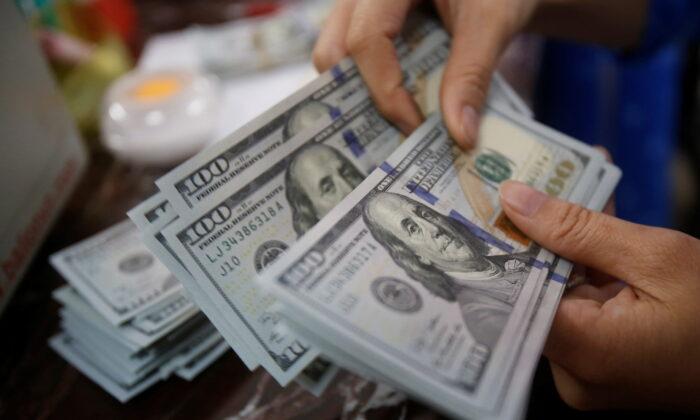LONDON—The U.S. dollar resumed its backward slide on Monday as risk appetite across markets tentatively strengthened, supported by more encouraging economic data and bets that the Federal Reserve will tighten policy at a slower pace.
The dollar index—which tracks the greenback against six major rivals—is on track for its first monthly drop in five, as the safe haven currency loses steam after a breakneck start to the year.
The dollar index is on track for a more-than 1.5 percent drop in May—although it remains up about 6 percent on the year. It was last down a quarter of a percent on the day at 101.44.
Trade was likely to be light through Monday as U.S. stock and bond markets close for the Memorial Day public holiday.
Data on Friday showed that U.S. consumer spending rose more than expected in April as households boosted purchases of goods and services, and the increase in inflation slowed.
Analysts said the encouraging data, coupled with bets on a more cautious tightening path by the Fed, was weakening the dollar.
European shares scaled more-than three-week highs on Monday as easing COVID-19 restrictions and new stimulus in China helped sustain last week’s optimism.
“How the US consumer plays out from here and from a global perspective how the Chinese economy performs will be crucial determinants for broader investor risk appetite,” currency analysts at MUFG said in a note.
A slew of further economic data is due this week which could give clues on the outlook for global growth, including U.S. jobs numbers and Chinese Purchasing Managers’ Index figures. German inflation data is expected at 1200 GMT today, ahead of eurozone inflation figures on Tuesday.
German annual inflation is expected to have risen to 8 percent, according to Refinitiv data, having hit a four-decade high of 7.8 percent last month.
The euro hit a monthly high versus the dollar of $1.07705, up 0.3 percent, ahead of the data.
The safe haven yen fell back 0.2 percent to 127.330 yen per dollar.
Sterling edge up 0.1 percent to $1.26400.
Cryptocurrencies attempted a bounce but bitcoin, which rose 4 percent, is still pinned around $30,000.





